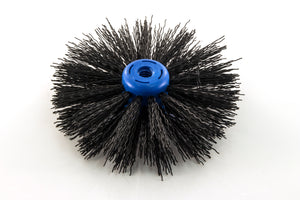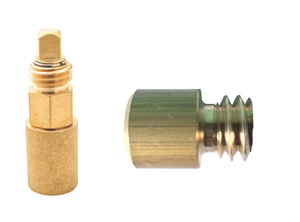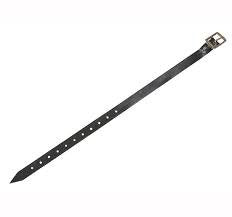Let's go back to basics - why do you need to sweep your chimney?
A few of the main reasons are:
-
To avoid a chimney fire- according to statistics there are on average 7000 chimney fires a year in England alone, most of which were preventable. Having your chimney swept will drastically reduce the chances of having a chimney fire, also insuring the wood you are burning is dry and has a moisture content of below 25% will help further reduce chances of a chimney fire.

-
Protects your health- breathing in fumes from solid fuel or gas fires can cause respiratory problems. Ensuring your chimney is swept will make sure the flue is clear to allow these dangerous fumes escape safely through the chimney
-
Avoid Smoke damage- every time your stove is lit soot will accumulate up the chimney. If this goes uncleaned this will gradually reduce the size of the flue and in turn reduce the draw of the smoke upwards. If this flue is reduced too much this can cause smoke to enter the room which can cause irritation and blacken up the fireplace.
-
Clearing Blockages- Sweeping a chimney will also ensure the safe removal of obstructions that may have lodged inside the flue such as nests, cobwebs, Flue collapse (loose brickwork), which could obstruct the safe exit of fumes.
How often should I have my chimney swept?
This depends on how often the fire is used and what you burn. A general guideline as advised by the Guild of Master Chimney Sweeps is
- Smokeless coals At least once a year
- Wood Up to four times a year
- Bituminous coal Twice a year
- Oil Once a year
- Gas Once a year
What are the advantages of flexible chimney rods compared to conventional sweeping rods and brushes?
Flexible rods are able to bend upto 180° meaning they can get in the tightest of flues.
What happens if I burn unseasoned wood?
Burning wet or unseasoned wood should always be avoided, the main reason for this is as the gases rise up your chimney stack, the moisture in these gases condensate on the inner walls of the chimney stack and set as a hard tar. This is in most cases will not be able to be removed and if built up could catch fire leading to a large chimney fire. Burning wet wood also gives little heat and may spit sparks into the room. You can avoid the risk of burning wet wood by buying a moister meter, this way you can reject damp wood. The wood you burn should not have a moister content of over 25%, anything higher will cause excess build-up of tar and creosote. Use only recommended fuels for your appliance and flue type (If you are unsure check your manufactures instruction or ask your stove supplier).
What causes a chimney fire?
The most common causes of chimney fires are:
- Infrequent sweeping and cleaning
- Burning unseasoned wet wood
- Improper appliance sizing
- Overnight burning or smouldering wood for long periods in wood stoves
What should you do if you have a chimney fire?
In the event you have a chimney fire evacuate the building immediately and call 999. Do not use your chimney again until it has been assessed by an appropriate specialist such as a Hetas registered or NACS registered engineer.
How to sweep a chimney yourself
There are reasons to get a trained professional to sweep your chimney, particularly if you have any kind of safety concern or you need an insurance certificate, however it is something that you can certainly do yourself.
There are two approaches to sweeping a chimney with rods; you can insert the rods at the bottom and push them up or you can do it the other way by pushing the rods down from the top.
Here we’ll describe the “bottom to top” method as it is easier and shouldn’t require clambering about on the roof.
A word of warning here is to make sure you do not try to sweep the chimney for at least 12 hours after the fire has gone out. Soot can stay hot for a long while.
The steps for sweeping your own chimney:
- Cover: Firstly cover everything in the room with dust sheets and turn your hoover on. Have the hose lying on the hearth
- Inspect: You will have had a look to ensure that you have got the right size brush, but take a moment again to look for animal wastage or other blockages. Ensure that there has been no damage and try to get a feel for how much creosote and soot build up there is as this will indicate how much scrubbing is needed – use a poker to have a good scrape

Have a close inspection of the chimney before you start sweping
Ensure you purchase the right size brush, we recommend at least ½ an inch (15mm) wider than the chimney.
- Sheet up – Put your old bed sheet against the fireplace opening. Tape the top of the sheet to the fire surround – only the top at this stage as you will still need to get the brush in there!
- Get Ready – Put the brush inside the fire opening and insert the first rod through the hole in the middle of your sheet. Connect the brush and leading rod. Get it ready to insert into the chimney
- Tape Up – Now that you don’t need to get into the fireplace and everything is ready, tape up the sheet to the fire surround. Do this well, make it as tight and secure as possible – don’t spare the tape! Any gaps and falling, sooty debris will get through
- Rod Up – Push the leading rod and brush up the chimney, connecting more rods as you go. Note: We have recommended you use lockfast rods in our Chimney Sweep Kit but it is cheaper to get screw-type rods
If you opt for screw rods, use a good quality ¾ inch drain, or chimney sweeping rod set and affix the brush tightly. The rods will screw together in a clockwise direction so, when turning the rods as you push the brush up the chimney, make sure you turn in a clockwise direction.
Push the rods up the chimney so that the brush sweeps all the way to the top.
This will keep the joints on the rods tight. If you twist the rods in an anti-clockwise direction there is a good chance you will undo a joint and get the rods and brush stuck up the chimney.

Using one rod with the brush on, push the brush up the flue. Twist slightly (in a clockwise direction) until you can only see 300mm of the rod.
Attach another rod and repeat. Do not attempt to push too hard. Just a little at a time will dislodge small areas of soot and this will be much easier to manage than a lorry load pouring down all at once!
- The Top – Once the brush reaches the top you should feel it, but you can pop outside and check it. Many professional chimney sweeps will ask you to go outside and have a look to confirm that they have swept the full length

The brush should come out of the top of the pot
Chimney Sweeping Guide
Bailey Flexible Nylon Pro Pack Chimney or Drain Rod Set 10m With Holding Straps
Cleaning Rod Sets










